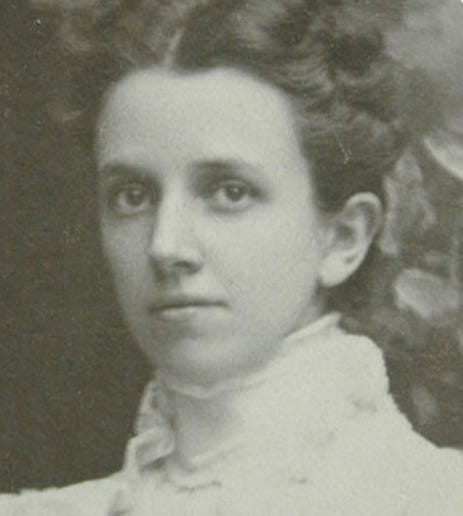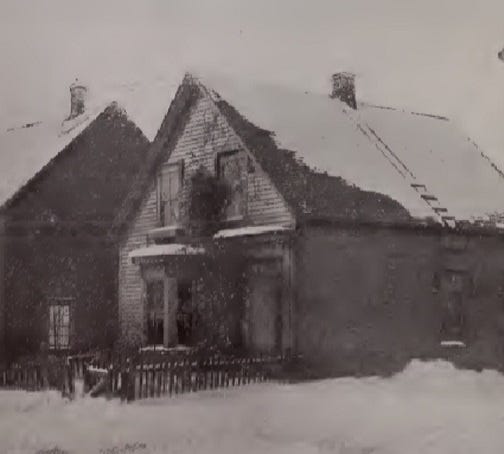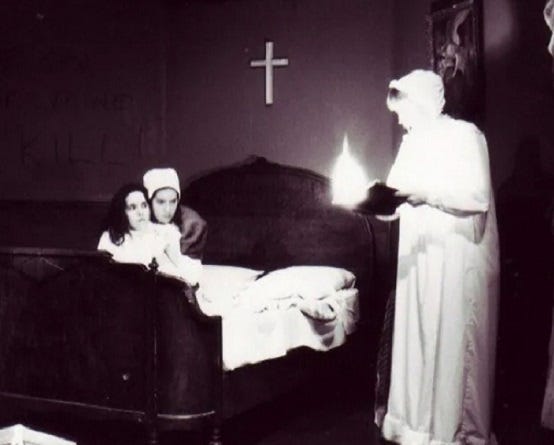The Haunting of Esther Cox
Few stories in the annals of the paranormal are as perplexing as that of Esther Cox. To some, she was a scammer, plain and simple, who used her feminine charms to manipulate those around her. Others, more sympathetic to her plight, viewed her as the victim of an evil force by which she was relentlessly tormented. After perusing the details of her ordeal, you can decide for yourself on which side of the fence you stand.
Esther was the youngest of six children, born to a twice-married farmer in the Canadian province of Nova Scotia in the spring of 1860. Although the family barely scraped by, the little girl’s childhood was a happy one. If any trouble was brewing in those early years, her hard-working parents had been too busy to notice.
When Esther was eighteen, she was visiting an acquaintance named Bob MacNeil when things took an ugly turn. Without warning, the man she had always considered perfectly harmless grabbed Esther and threw her to the ground. In the terrifying moments that followed, MacNeil allegedly attempted to sexually assault the teenager.
Summoning all of her strength, Esther managed to fight off her assailant just long enough to escape. Although she survived with few physical scars, the damage done to her psyche was greater than anyone knew. The traumatized girl would soon discover, as would a host of others, that the attack had awakened something that would take the better part of a year to put to rest.
Esther reported the offense to police who viewed her story with unveiled skepticism. Bob MacNeil was, as far as they were concerned, an upstanding citizen. In the end, they concluded that Esther’s account didn’t hold water. As a result, no arrest was made. If MacNeil had indeed brutalized the teenager, he got away unscathed. She, however, did not.
Shortly after the incident, strange activity began to occur in the Amherst home belonging to Daniel Teed and Esther’s sister Olive, with whom she had been living for some time.
The disturbances were subtle at first. A tapping sound would be heard emanating from someplace in the house that no one was able to pinpoint. Within days, it developed into a loud hammering that would continue for hours on end.
Bedclothes, along with other household items, began moving by themselves. As the situation progressed, heavy furniture would flip itself over in full view of the home’s disbelieving occupants.
During this period, Esther insisted that someone was following her, especially when she ventured into the basement to do chores. Though she couldn’t see the culprit, their presence was enough to make goosebumps rise on her flesh.
When posed questions, the source of the mischief would respond with a disembodied knocking, once for yes, twice for no. At other times, the entity would pull words out of thin air and inscribe them on the walls.
Oftentimes, the phrases were shocking to behold, especially given the time period. The crass comments were, on some occasions, bordering on the obscene. Other incidents were intimidating in a far more sinister fashion.
One threat made by the unseen being warned of its intention to burn the Teed home to the ground. As if to illustrate its point, lit matches began dropping from the ceiling. Around the same time, two fires erupted spontaneously inside the house. Fortunately, they were extinguished before they could do any serious damage.
The residence wasn’t the only thing affected by the scourge that was turning the family’s lives upside down. As the haunting progressed, Esther’s body would periodically swell to such a degree that she was nearly unrecognizable. She also began losing the ability to control her movements which resulted in her limbs jerking uncontrollably.
In addition to Esther, the Teed home also hosted two of her other siblings, William and Jennie, along with her brother-in-law. Space was limited, but the clan somehow managed. As far as they were concerned, family stuck together no matter what.
One night, as the household slept in quiet bliss, piercing screams had suddenly cut through the silence. Awakened by the ruckus, family members hurried in the direction of the cries, which led them to the room shared by Esther and Jennie.
The girls claimed that they had been jolted from sleep by sounds that seemed to be coming from a box that was stored under their bed. When they pulled the container out to investigate, it had “jumped” up, flipping itself over in the process. As the sisters watched in disbelief, the box had floated upwards, hovering momentarily in mid-air before crashing to the floor. It was this unprecedented event that had prompted the screams that had brought the rest of the family running to their aid.
A few nights later, Esther retired early, complaining that she wasn’t feeling well. When it was time for Jennie to turn in, she crept into the room, careful not to wake her ailing sibling. As she climbed into bed, she claimed that Esther suddenly jumped up, tearing at her clothing and screaming “My God! What is happening to me? I’m dying!”
A panicked Jennie could see by the lamplight that her sister’s skin was glowing bright red. Her body was so unnaturally bloated that her airway was constricted, causing her to gasp for breath. It had taken the combined efforts of Jennie and Olive to get Esther back into bed.
Both women would later assert that Esther’s skin had been so hot to the touch that it had burned their hands. They also said that, even as she lay in bed, her body continued to puff up to such an extent that they feared she might burst. Her skin was stretched so tightly that it glistened in the dim light.
As Esther writhed in pain, her sisters struggled to hold her down. In the midst of the chaos, a thunderous boom rocked the house. Three more followed in quick succession. Within minutes, Esther’s form returned to normal. Her skin, which had been as taut as an overblown balloon, regained both its color and elasticity.
The harrowing scenario repeated itself four nights later. This time, unable to gain control of Esther, her siblings sought help from their trusted family physician, Dr. Carritte.
The good doctor later recounted that, while in the home, he witnessed a pillow shift by itself beneath Esther’s head. He also reported hearing a scratching sound with no discernible origin. Most alarmingly, he observed the words, “Esther Cox, you are mine to kill,” as they were being scrawled on the wall by something neither he, nor anyone else, could see. He estimated that the letters had been at least a foot tall.
In the moments that followed, a large chunk of the wall detached and was hurled in Dr. Carritte’s direction. It was evident, even to the man of science, that something unknown to him was not happy with his meddling in its affairs.
Thoroughly shaken, the physician departed for the night, but promised that he would be back. He was, if nothing else, devoted to his calling.
On his next visit, the doctor reported seeing potatoes being thrown across the room by an invisible force. He also claimed to have heard something banging on the roof when there was no one in sight.
Dr. Carritte wrote in his notes that, had he not witnessed the goings-on at the house for himself, he would never have believed such events were possible. Unfortunately, he knew his limitations, admitting that it was not within his area of expertise to help the desperate family.
And, so, the haunting continued. Esther, who had always been the focal point of the disturbances, remained under attack. Family members and guests alike said that, on numerous occasions, they heard a slapping sound that would cause Esther’s head to whip to the side. Within seconds, an angry red mark in the shape of a human hand would manifest on her cheek.
As those around her watched helplessly, stick pins would materialize from thin air and embed themselves in the soft flesh of Esther’s face. One day, while a neighbor boy was visiting, a pocketknife he was carrying flew from his hand and stabbed Esther squarely in the back. Witnesses defended the child, saying that he had been as bewildered as everyone else at the occurrence.
Hoping to find sanctuary from her demons, Esther showed up for services at a local church one Sunday morning. As she settled into a pew, a loud rapping sound filled the venue. While parishioners looked around in wonder, the noise grew louder, effectively drowning out the sermon.
With all eyes upon her, Esther ran from the house of worship, taking the source of the disturbance with her. She realized then and there that, for her, no place was safe.
By this time, the entire province was familiar with Esther’s predicament. She had become, for some, a minor celebrity. As such, she was pursued by more than a few paranormal enthusiasts whose motives were not always pure.
One such hanger-on was a part-time actor named Walter Hubbell. After reading about Esther’s ordeal, he sought out the family, assuring them that he was simply a concerned citizen who was sympathetic to their loved one’s unfortunate situation.
Touched by his outpouring of support, the family allowed Hubbell to move into their home in order to document the activity firsthand. While there, he claimed to have witnessed a multitude of phenomena.
According to him, Esther had identified some of her spectral tormentors by name. Among the guilty parties were a Mary or Maggie Fisher; Eliza McNeal; Jean and Bob Nickel and a fellow named Peter Cox.
It was unclear whether or not any of the alleged perpetrators were known to Esther in life. It is telling that some of the names were slight variations of both her own and that of her alleged attacker, Bob McNeil.
Suspecting that he had stumbled onto a potential goldmine, Walter Hubbell, who by now had gained the family’s unwavering trust, began acting as her agent. It was he who convinced her to take her show on the road. He assured the naïve girl that the public would pay handsomely to hear such an amazing story straight from the source. Unfortunately for her, she believed him.
After only two dismal appearances, Esther’s career as a public speaker came to a screeching halt. As it turned out, people who read about the case in the newspaper were unwilling to fork over their hard-earned money for a rehashed version recited by a nervous teenager.
In November of 1879, the haunting that had plagued Esther Cox for a year stopped as suddenly as it had begun. The end came, coincidentally, when she was arrested and convicted for burning down the barn of a family for whom she worked as a domestic servant.
Esther’s four-month jail sentence was petitioned by members of the public who took pity on the girl many believed to be the victim of circumstances beyond her control. Taking into consideration all that she had been through, the judge granted her leniency and ordered her released after serving one month behind bars.
It would later be explained that Esther had moved into her employer’s house as a way of protecting her own family from the entity with which she was cursed. As was to be expected, the destructive being had followed her and resumed its malicious activity at her new residence. It was this demon, according to her, that set fire to the barn, not she.
Rumors circulated that, while she was imprisoned, a First Nation’s Mi’kmaq witchdoctor had visited Esther. Many believed that it was this shaman, not the strong arm of the law, who had banished the evil spirit that had set its sights on the teenage girl.
Not everyone supported the long-suffering Esther. More than one in the community felt that she was not a victim at all, but rather, a master manipulator who had instigated a hoax. Her ultimate goal, as far as they were concerned, was to use her sudden fame for financial enrichment.
The way they saw it, when Esther realized that there was no money to be made, she abandoned the entire charade. They cited Hubbell’s ill-conceived roadshow as proof of her questionable motives.
Her detractors painted Esther as somewhat of an enchantress. She had, in their collective opinion, possessed the enviable ability to alter the way others perceived reality. Somehow, the farmer’s daughter had bewitched all those around her to such an extent that they saw only what she wanted them to see. These naysayers failed to elaborate on how she had not only managed such a feat but kept up the ruse for twelve tortuous months.
The events surrounding Esther Cox, which became known throughout Canada as the Great Amherst Mystery, were immortalized in print by the always resourceful Walter Hummell. His insider’s account was published in 1879, shortly after the haunting ended. It detailed what he, and others, observed while in the Teed home.
In all, sixteen witnesses whose experiences were featured in the book swore in an attached affidavit that the incidents depicted in Hubbell’s work were true. Each one attested to the fact that Esther had been hounded relentlessly by something not of this world. They had seen the evidence firsthand. They were also adamant that they had not fallen for trickery perpetrated by Esther or anyone else. What they had seen and heard had been frighteningly real.
Among those who stood steadfastly behind the story was Dr. Carritte. The respected physician echoed the sentiments of the other interviewees. He insisted that the horrors that Esther endured had not been fabricated. She was, he believed, one of the few indisputable victims of a targeted haunting.
For her part, Esther chose to move on, leaving the past behind her. After things returned to normal, she relocated to the United States, settling in Massachusetts where she would reside for the remainder of her life. She died in 1912 at the age of fifty-three taking any secrets, if they did exist, with her to the grave.
Resources:
·cbc.com
·True North True Crime
·amherst.ca
·wiki.com
·halifaxexaminer.ca
·bbc.co.uk
·the-line-up.com
·astonishinglegends.com
·ranker.com
Images used under provisions of the Fair Use Act for purposes of reporting and education.






